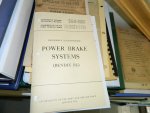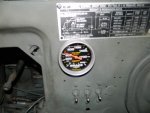rustystud
Well-known member
- 9,280
- 2,987
- 113
- Location
- Woodinville, Washington
Actually there is NO big rig or bus today that uses the system that cars did. They all have anchored brakes. The reason is that the "floating anchor is not strong enough to handle the pressures needed on something like a 8" to 10" wide brake pad.Deuce brakes are "intresting", being basically a 1930s design. Because they use a single wheel cylinder and duel fixed anchor pins there is only one leading shoe, and one trailing shoe for each drum, and the shoes switch depending on vehicle direction when the brakes are applied.
When you are going forward and apply the brakes, the forward shoe becomes the leading shoe, when you are in reverse, the rear shoe becomes the leading shoe, this also means that the brakes work equally well, (or bad), in either direction.
But in reality, you don't often have to make hard/fast stops from high speed in reverse, and so the Deuce design, while strong and simple is lacking in stopping power by modern standards.
In most any type of drum brake, the leading shoe does most of the work. With the fixed anchor pin design, you effectivly give-up ~25>30% of your braking power,, but with enough power assist rhe system works.
The modern system, (Kelsey-Hayes/Bendix)whereby the shoes are connected together by a "floating" anchor allows both of the shoes to "cam" themselves into the drum, resulting in a large increase in stopping power for the same brake-line hydraulic pressure.
The "floating anchor" system was originally designed for aircraft, which, (as planes got bigger/heavier/faster landing speeds), needed brakes that would "stop" without power assist.
The modern shoes have actual bushings in the shoes (that must be lubed) due to the forces they must deal with. The only thing the deuce needs is a "S" cam tied to a air-can to make it a modern design.






